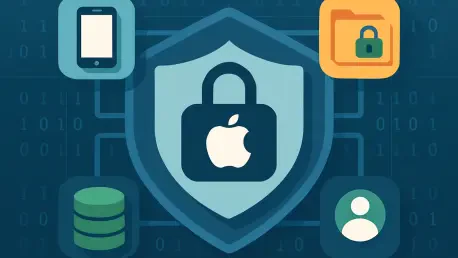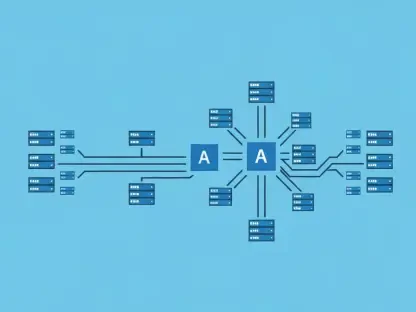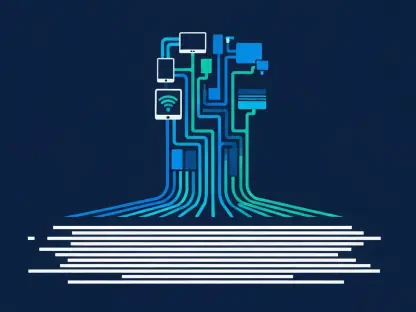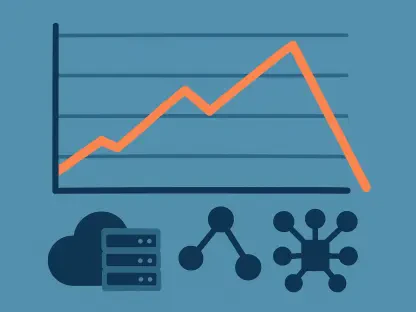In an era where digital threats loom larger than ever, with cyberattacks targeting personal information on a daily basis, the importance of robust data protection cannot be overstated, and imagining a scenario where a single breach could expose sensitive details like financial records or personal messages to malicious actors highlights the urgency. This is the reality many face, making the need for comprehensive security measures more critical than ever. Apple has positioned itself as a leader in this space, crafting an intricate eight-layer security framework designed to shield user data from every conceivable angle. From the deepest hardware components to the outermost network interactions, this system integrates cutting-edge technology and stringent policies to create a formidable barrier against threats. This article delves into the specifics of how Apple ensures that user privacy remains paramount, exploring the multi-faceted approach that sets a benchmark in the tech industry for safeguarding personal information.
Hardware: The Bedrock of Security
At the core of Apple’s defense strategy lies hardware-level protection, a foundation that ensures security starts the moment a device powers on. Every Apple product is equipped with a Boot ROM that is immutable, meaning it can only run software bearing an official signature, effectively blocking unauthorized access right from the initial boot. Beyond this, the Secure Enclave—a specialized compartment within Apple’s chips—plays a pivotal role by securely housing sensitive data like biometric identifiers for Face ID and Touch ID. This data never leaves the enclave, with only a simple confirmation or denial relayed to the broader system during authentication. Additionally, a dedicated AES hardware engine manages encryption and decryption processes, ensuring that even the main processor cannot access unencrypted data. This meticulous isolation of critical information establishes a robust first line of defense, making it incredibly challenging for attackers to compromise the device at its most fundamental level.
This hardware-centric approach extends further with features designed to thwart physical tampering or theft. For instance, the integration of encryption at the chip level means that even if a device falls into the wrong hands, the data remains inaccessible without proper credentials. On top of that, Apple’s design ensures that sensitive operations are compartmentalized, reducing the risk of a single point of failure. The significance of this cannot be understated, as it prevents potential exploits from escalating into full system breaches. By embedding security directly into the hardware, Apple creates a barrier that is not reliant on software updates or user intervention, offering a consistent shield against evolving threats. This layer is particularly vital in an age where physical attacks, such as device theft, are as much a concern as digital ones, demonstrating how Apple anticipates and counters risks at the most basic structural level of its products.
Operating System and Application Safeguards
Moving beyond hardware, Apple’s operating system forms another critical layer of its security framework, incorporating mechanisms to protect the system’s core and user data. Kernel Integrity Protection (KIP) is a standout feature, preventing any unauthorized changes to the system kernel once the device has booted, thus maintaining the integrity of the operating environment. Alongside this, strict controls ensure that only trusted code can execute, minimizing the risk of malicious software gaining a foothold. File encryption adds another dimension of safety, with System Data Protection automatically securing new files using a 256-bit key. For Mac users, FileVault technology takes this further by encrypting entire drives, rendering data unreadable to unauthorized parties even if the device is stolen. These combined efforts create a fortified operating environment where data remains protected at rest and during system operations.
Equally important is Apple’s approach to application security, which is meticulously designed to prevent rogue apps from compromising user safety. Every app undergoes a rigorous pre-publication review to catch potential threats before they reach users, while notarization processes scan for malicious code. Sandboxing further enhances this protection by confining apps to their own data spaces, ensuring they cannot interfere with the system or other applications. This isolation is crucial in preventing a single compromised app from affecting the entire device. Additionally, Apple’s services like iMessage employ end-to-end encryption, meaning only the intended sender and recipient can access the content of communications. Attachments stored in iCloud are separately encrypted with keys embedded in the messages, adding another layer of assurance. This comprehensive strategy underscores how Apple prioritizes both system stability and application integrity to safeguard user information.
Network and Corporate Protections
On the network front, Apple implements sophisticated measures to protect user data during transmission and interaction with external systems. One notable feature is the use of randomly generated MAC addresses for Wi-Fi connections, which prevents tracking and preserves user anonymity online. Additional safeguards are in place to counter techniques that might expose device identities, ensuring that personal information remains hidden from prying eyes. Development frameworks such as HomeKit and HealthKit also adhere to strict security standards, utilizing end-to-end encryption for all communications. Even seemingly minor data, like the status of a connected smart device, is encrypted to prevent interception. Device certification before pairing adds yet another layer of trust, ensuring that only verified devices can interact within Apple’s ecosystem, thereby reducing the risk of unauthorized access.
For corporate environments, Apple offers robust tools to manage security at scale, catering to the unique needs of businesses. Centralized device management allows IT administrators to enforce strict policies, such as mandatory password requirements, app restrictions, and remote data wiping capabilities. These controls are embedded at the system level, making them resistant to tampering by end users. Administrators can also mandate software updates to ensure devices remain protected against the latest threats. This level of oversight is invaluable for organizations handling sensitive data, as it provides a structured way to maintain security across numerous devices. By integrating these corporate-focused features, Apple ensures that its security framework is adaptable to diverse use cases, protecting not just individual users but also entire enterprises from potential vulnerabilities in an increasingly connected digital landscape.
Reflecting on a Privacy-First Philosophy
Looking back, Apple’s commitment to user privacy through its eight-layer security framework stands as a testament to technical innovation and a deep-rooted belief in privacy as a fundamental right. Each layer, from hardware isolation to network defenses, was carefully crafted to address specific threats, creating a holistic system that leaves little room for exploitation. The rigorous app oversight and encrypted communications demonstrate a proactive stance against risks, while corporate tools showcase adaptability to varied needs. This multi-faceted approach not only protects data across countless touchpoints but also sets a high standard for the industry. Moving forward, users and organizations alike can take confidence in these robust defenses, considering how to leverage Apple’s ecosystem for enhanced security. Exploring further integrations or advocating for similar privacy standards in other platforms could amplify protection in the broader tech landscape, ensuring that data remains a guarded asset in an ever-evolving digital world.









